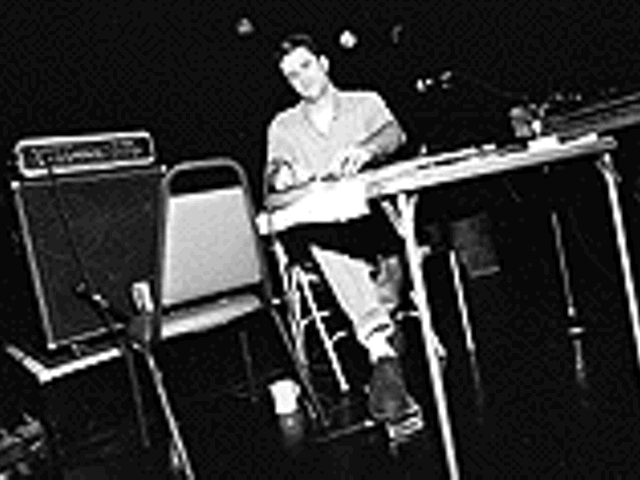So you've been listening to nothing but goth-rock for 10 years but find yourself developing a taste for '60s soul? The lame white-boy funk you're hearing on the alt-rock station has sparked an interest in the source, James Brown? Or possibly you've recently discovered The Album, the one that widens your horizons and gives you a taste for more, but you don't know where to go next. It would be nice to just go to a record store and fling cash all over the place, but most of us have to choose wisely. Maybe you should read a book or something. A small industry now exists to publish music guides, dense books designed to review the collected works of the rock and pop era, to tell you which records you'll love and which you'll loathe.
"We definitely try to point people in the right direction," says St. Louis native and frequent RFT contributor Daniel Durchholz, who co-edits MusicHound Rock: The Essential Album Guide (Visible Ink, $26.95) with Gary Graff. Published by the same press that issues the popular VideoHound series of video guides, the album guide takes a similar consumer- oriented approach.
"I don't think the goal was to be encyclopedic," says Durchholz. "Some of the others try to review as many albums as they can cram in by each artist, or give a detailed band history: In such-and-such a year, they put this album out. We tell you what to buy and, just as importantly, what to avoid. It gets a little more opinionated and maybe a little more lively." Music-Hound's coverage is certainly eclectic: There's room for both Skid Row and Sleater-Kinney. And the MusicHound rating system uses bones — hound, bones, get it? — instead of the usual stars to answer the question, as Durchholz puts it, "What are the essential albums of the rock era?" He notes, "In the back of the book there's a list of all the "five-bone' albums, so that anybody can buy any of those and come home with something good." Graff and Durchholz manage to add some unique elements to the MusicHound guide. Each artist has "rewind" and "fast forward" sections, listing (respectively) their influences and acts they may have influenced. "I know it's hard to imagine some kid who's into Soundgarden not knowing about Led Zeppelin, but we try to point those things out," says Durchholz. Periodic quotes from musicians about which albums changed their lives can give the reader some unexpected insights. Who would have thought that a guy from Chumbawamba used to stay up nights arguing about whether Jimmy Page is a better guitarist than Ritchie Blackmore? And beyond the A-Z format, several special sections cover compilations, Web sites, books and magazines, and radio stations.
But as good as MusicHound is, it's not the only source of rock & roll education. Curious about the history of the pop charts? Need to know what the Brill Building was? Never heard of skiffle? The latest edition of the Penguin Encyclopedia of Popular Music (Penguin, $22.95) may help. As indicated by the title, its scope is not limited to rock music. Taking as its turf "non-classical music this century," its cheerful stew of styles and eras is nourishment for any rock & roller curious about pre-rock pop music or relevant tributaries, from jazz to Tex-Mex; in a publishing-industry first, Rahsaan Roland Kirk and Kiss can be found on the same page. Although the prose is hardly captivating, the entries are concise and substantial in true encyclopedia style. Also of note: an amusingly fogeyish attitude toward all things loud, rude and modern. At one point we are told that Joni Mitchell's records "will still be selling when Guns n' Roses are forgotten."
This mindset does tend to limit the coverage of punk, metal and hip-hop, but anyone who looks to this book for heavy-metal advice probably doesn't have a Motorhead back patch on his or her denim jacket in the first place.
Another large and readable selection is The Rough Guide to Rock. Although its genesis as a Web-based fan-written anthology may stir some doubts, put them aside. Virtually every entry is sharp and informed, and most even have a sense of humor about their subjects (the Amboy Dukes/Ted Nugent item is crack-up funny). The entries are somewhat longer than the norm, and well-chosen photos with clever captions make the book even more browse-worthy. Its British sensibility is close in spirit to magazines like Q and Mojo, and leads to some interesting inclusions: The Redskins and the original Nirvana are here, whereas Kansas and Lionel Ritchie are left out. It's not an exhaustive reference, but this approach captures the excitement and grand sweep of rock & roll better than anything else you can buy. Be warned that The Rough Guide to Rock will make you want to go buy records. Late addendum: The first edition is just now out of print, in anticipation of a new edition to be released this winter.
The All Music Guide to Rock (Miller Freeman, $26.95) is a sprawling behemoth packed with small type. It's admirably comprehensive, including bootlegs in discographies and featuring many entries for artists found nowhere else. The coverage of '60s British rock is particularly impressive. Unlike MusicHound, its compilations section has full reviews of each album. And a great section of essays on different genres, complete with family trees and recommended albums, would be a valuable book in itself. You won't find better overviews of blue-eyed soul, pub rock or New Zealand power pop in this world or the next. But the ratings-system blues set in. Sometimes it seems as if these guys are pulling numbers from a hat. Evidently whoever writes reviews is not necessarily the same person who rates the albums, leading to confusing and contradictory advice. And the tiny print makes it hard to look through for any extended amount of time. If you're planning to buy this one, invest in a magnifying glass.
Anyone who remembers when alternative music was called "wave" will be saddened to hear that the original Trouser Press Record Guide has gone out of print. "I grew up with that one," says Durchholz. First issued in 1983 and last updated in 1992, the Guide featured great writers like Jack Rabid and editor Ira A. Robbins, who were never afraid to puncture the pompous. Here's Robbins on Jane's Addiction: "Obnoxious Los Angeles glam-punk poseurs ... (their first album) sounds like an Aerosmith cover band. (Perry) Farrell's habit of lamely interjecting the word "motherfucker' into his lyrics merely frosts the album's maggotry." And that's just the first paragraph. Although Trouser Press started with a narrower brief than most — new wave, alternative, whatever — it expanded over the years to include not just punk and power pop but reggae, hip-hop, thrash metal and progenitors like Lou Reed and Neil Young. The fourth edition was a monumental work, and its demise is unfortunate.
But there are some consolations. First, the entirety of the earlier editions is available online at www.trouserpress.com in an easily searchable database, along with periodic new columns by Robbins. Second, Robbins has produced The Trouser Press Guide to 90s Rock (Simon & Schuster, $24.95), which doesn't include any of the material from earlier guides but does apply the Trouser Press spirit to this decade's music. Although the '90s guide is worth having, the loss of the earlier book is a tragedy. May misfortune befall whatever Simon & Schuster exec decided on this shameful move.
The clunky, unwieldy Great Rock Discography (Times Books, $32) is about as readable as a stock ticker, and the only graphics are cornball caricatures of rock stars. Although the book's big selling point is its discographical minutiae, it's marred by dumb errors. The third Oasis album is not called Stand by Me; would it have been so difficult to get this one right? If you want to spend too much money on a big heavy book that's free of charm on one hand and reliability on the other, look no further. The Rolling Stone Record Guide (out of print, but used copies are easy to find) was for years the only player in the field, and you can tell; it's generally lazy and dull. Another must to avoid: the flimsy, shallow Spin Alternative Record Guide (Vintage, $20), a slicked-up cash-in job. Of a far better order are Robert Christgau's guides to the '70s and '80s, but their limited scope and selection make them more like Christgau-essay collections than the kind of encyclopedias found above. He's always great reading, but these books will not help the rock & roll vagabond find his way through the woods.
When you want to buy music, it may seem perverse to buy a big expensive book first. It's a whole lot more perverse, though, to pay 15 bucks for a CD, then sell it for $4 a week later. "There's just so much more music out there than ever before," Durchholz said. "You just need to be so much more critical now."





